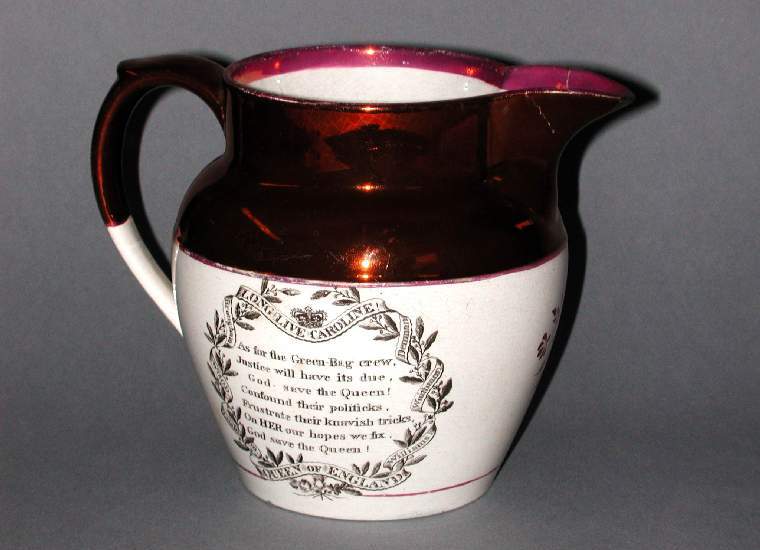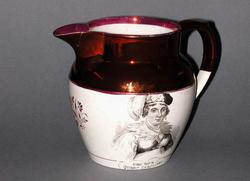Awaiting location update
Titles
Queen Caroline jug
Maker(s)
Factory:
Unidentified factory
(Probably)
Entities
Categories
Description
White earthenware, transfer-printed in black with text and images, then painted with and dipped in copper lustre.
Jug with ovoid body, cylindrical neck, curved lip and loop handle (with thumb-piece). Decorated on the body with two transfer-prints, in black. The underside is flat and glazed, with a raised foot-rim.
The image and texts are as follows:
(i) A bust of Queen Caroline, wearing plumed hat, lace collar and cameo necklace, above ‘GOD SAVE / QUEEN CAROLINE!’
(ii) A garland of leaves woven with ribbon inscribed ‘LONG LIVE CAROLINE!’ at the top, ‘QUEEN OF ENGLAND’ at the bottom, and the names ‘Brougham’, ‘Wood’, ‘Lushington’, ‘Williams’, ‘Waithman’, ‘Denman’ at the sides. The garland encloses the verse:
‘As for the Green-Bag crew,/ Justice will have its due,/God save the Queen!/Confound their politicks,/Frustrate their knavish tricks,/On HER our hopes we fix,/ God save the Queen!’
Notes
History note: Unidentified sale at Longstanton; bought by Mr Roger Roe; sold by him at Cambridge on 17 February 1912 for £1.5s (one pound five shillings), to Dr J W L Glaisher, Trinity College, Cambridge.
Legal notes
Dr J.W.L. Glaisher Bequest, 1928
Measurements and weight
Height: 14.5 cm
Width: 17.5 cm
Acquisition and important dates
Method of acquisition: Bequeathed
(1928-12-07)
by
Glaisher, J. W. L., Dr
Dating
George IV
19th Century, Early
Production date:
circa
AD 1820
Note
English lustreware was commercially produced from c.1805 and popular throughout the first half of the 19th Century. Staffordshire potters were the first and largest producers, though similar wares were also made in other regions and pink lustreware is often particularly associated with Sunderland. Potters used minute amounts of gold to produce copper, gold, pink or purple lustre, depending on the type of clay, lustre formula, number of layers and firing temperature; platinum was used to mimic silver. Most lustreware was made for everyday use, and factory markings are rare
In 1820, a Parliamentary Bill was placed before Parliament to dissolve the marriage of George IV and Caroline of Brunswick, on the grounds of her adultery. The couple, who were cousins, married in 1795 when George IV was Prince Regent, but they had been separated for some years by the time he became King and he did not want her as his Queen. She, however, had the passionate support of much of the population, and feeling in the country ran high. The Bill was eventually withdrawn, though Caroline was never crowned and died the following year. The names inscribed around the verse are those of the Queen’s supporters. The rhyme mimics the national anthem; Caroline’s accusers were known as the Green Bag Crew because they kept heir evidence in a type of green bag used by lawyers. The jug was made to sell to the Queen's sympathisers and seems to have been made in large numbers.
People, subjects and objects depicted
Components of the work
Decoration
composed of
lustre
( copper)
lead-glaze
transfers
Materials used in production
White earthenware
Techniques used in production
Throwing
: Thrown earthenware, transfer-printed then painted and dipped in lustre.
Inscription or legends present
- Text: GOD SAVE / QUEEN CAROLINE!
- Location: Below bust
- Type: Inscription
Inscription present: on a wavy ribbon over verse and under verse
- Text: LONG LIVE CAROLINE!’ at the top, ‘QUEEN OF ENGLAND at the bottom; Brougham WOOD Lushington Williams Waithman Denman
- Location: On other side
- Type: Inscription
- Text: As for the Green-Bag crew,/ Justice will have its due,/God save the Queen!/Confound their politicks,/Frustrate their knavish tricks,/On HER our hopes we fix,/God save the Queen!’
- Location: Inside garland
- Type: Inscription
- Text: ‘No. 3489. Queen Caroline jug with portrait & verse & copper lustre. 6”. b. inCambridge Feb 17, 1912’
- Location: Underside of base
- Method of creation: Rectangular paper label handpainted in black ink
- Type: Label
References and bibliographic entries
Identification numbers
Accession number: C.1162-1928
Primary reference Number: 71440
Old object number: 3489
Stable URI
Audit data
Created: Saturday 6 August 2011
Updated: Tuesday 30 April 2024
Last processed: Tuesday 15 July 2025
Associated departments & institutions
Owner or interested party:
The Fitzwilliam Museum
Associated department:
Applied Arts





